Abstract
OBJECTIVES. This study describes the prevalence and predictors of human immunodeficiency virus (HIV) risk behaviors among women living in low-income, inner-city housing developments. METHODS. Anonymous questionnaires were administered to 671 women living in 10 inner-city, low-income housing developments in five US cities to determine their levels of HIV risk behavior and predictors of HIV risk practices. RESULTS. Approximately one third of women were at high risk for HIV because of the risk behavior of their sexual partners. HIV risk was highest among women who accurately perceived themselves to be at increased HIV risk, held strong beliefs about barriers to condom use, and reported weak behavioral intentions to reduce risk. Women at higher risk were also younger and reported higher rates of alcohol and substance use. CONCLUSIONS. HIV prevention efforts are needed for inner-city women. Interventions should focus on overcoming women's barriers to condom use, strengthening their intentions to change behaviors, and managing the risk related to their use of substances.
Full text
PDF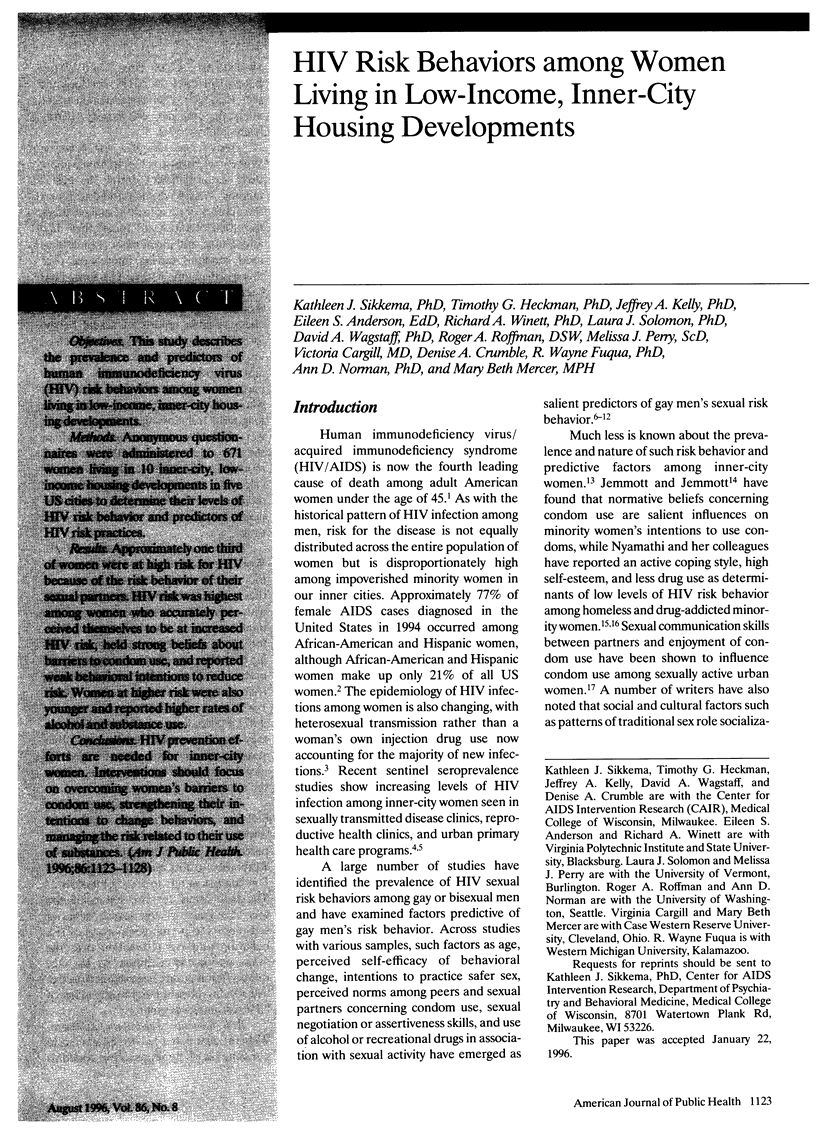
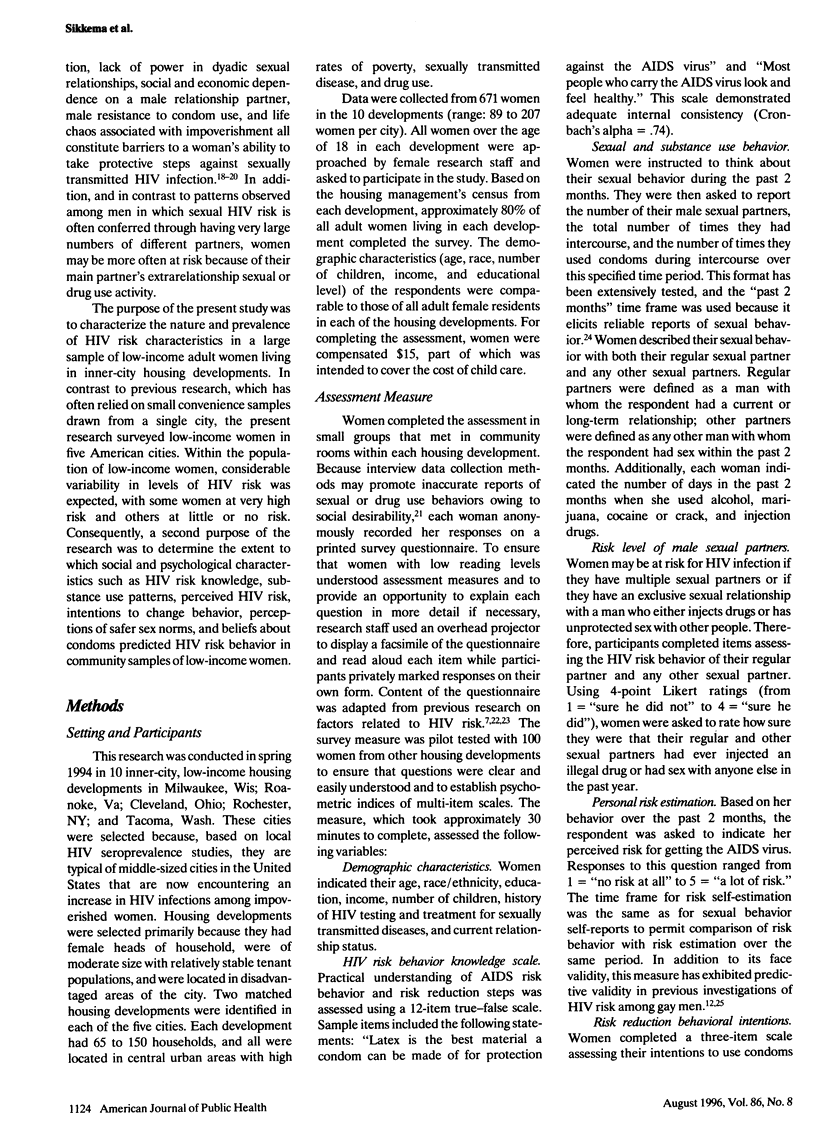

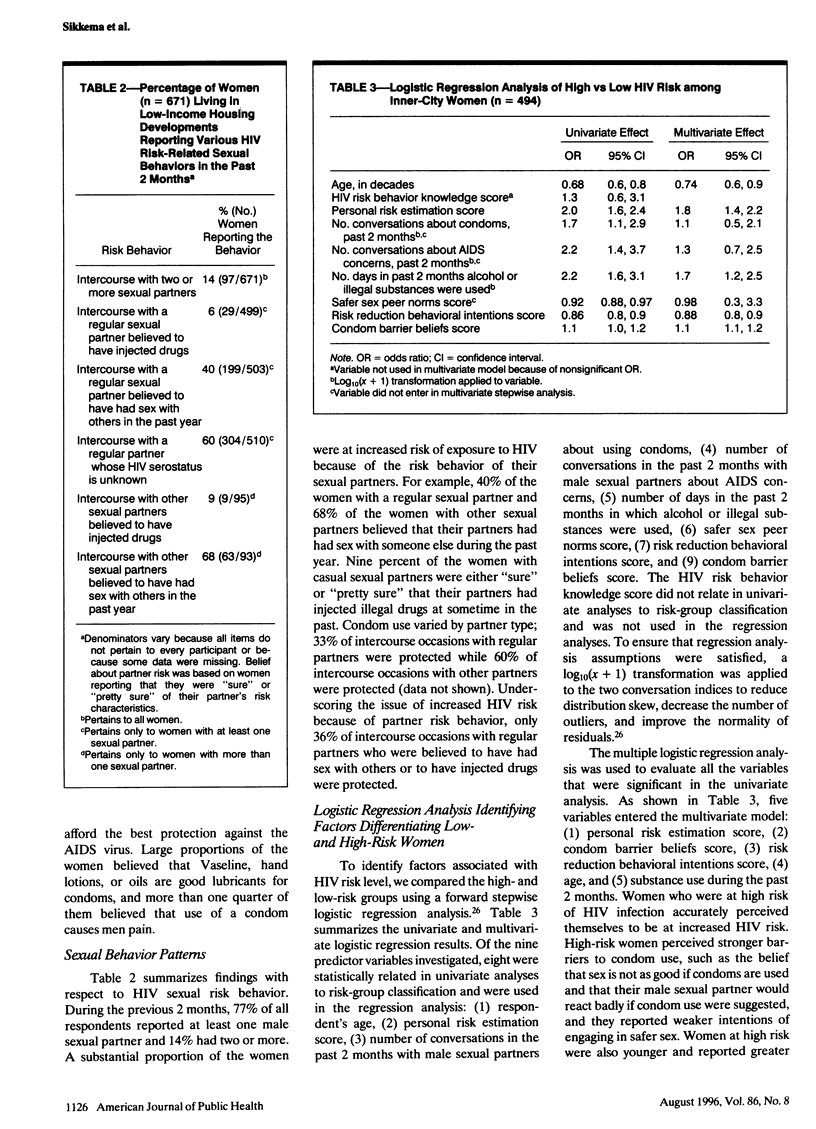
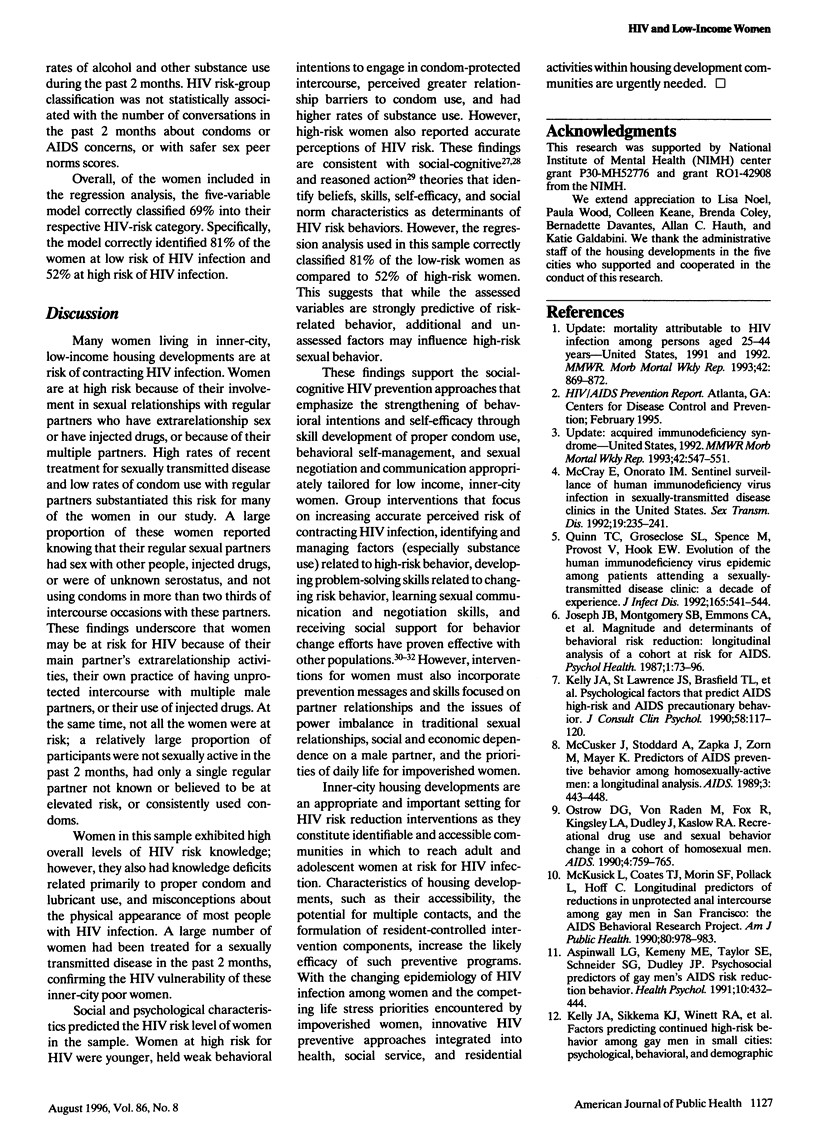
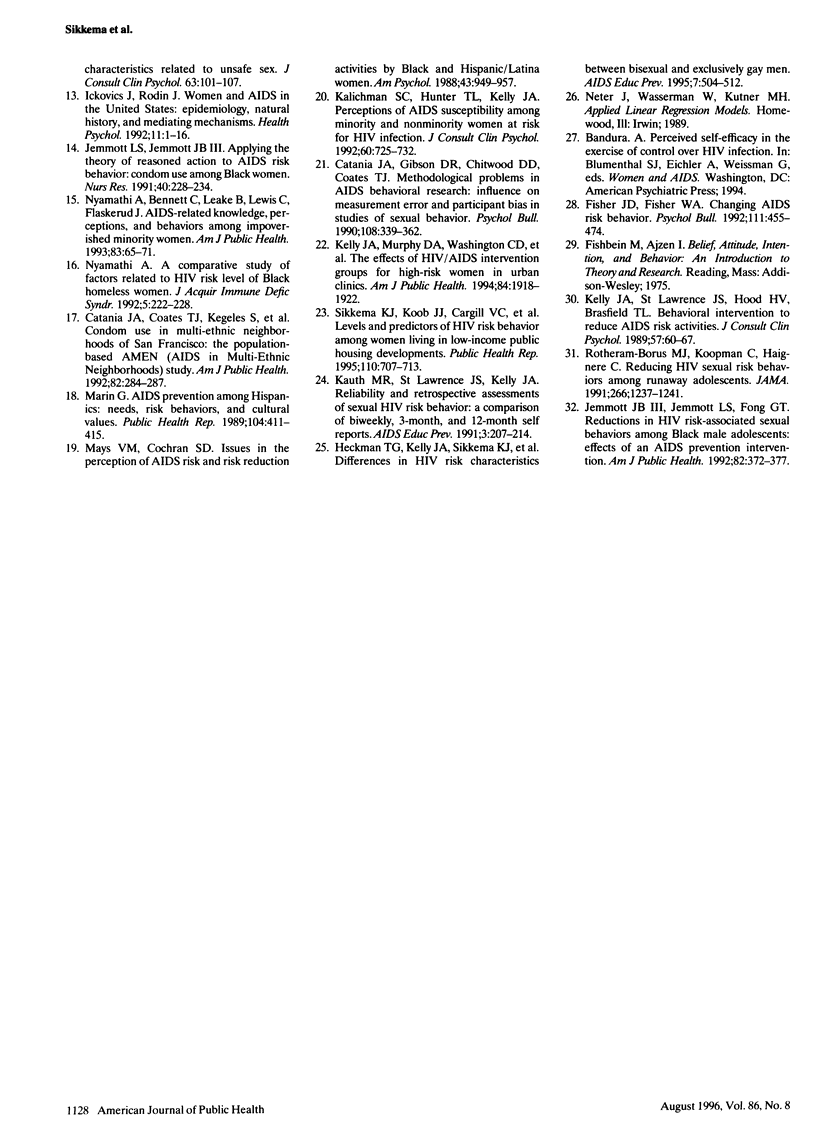
Selected References
These references are in PubMed. This may not be the complete list of references from this article.
- Aspinwall L. G., Kemeny M. E., Taylor S. E., Schneider S. G., Dudley J. P. Psychosocial predictors of gay men's AIDS risk-reduction behavior. Health Psychol. 1991;10(6):432–444. doi: 10.1037//0278-6133.10.6.432. [DOI] [PubMed] [Google Scholar]
- Catania J. A., Coates T. J., Kegeles S., Fullilove M. T., Peterson J., Marin B., Siegel D., Hulley S. Condom use in multi-ethnic neighborhoods of San Francisco: the population-based AMEN (AIDS in Multi-Ethnic Neighborhoods) Study. Am J Public Health. 1992 Feb;82(2):284–287. doi: 10.2105/ajph.82.2.284. [DOI] [PMC free article] [PubMed] [Google Scholar]
- Catania J. A., Gibson D. R., Chitwood D. D., Coates T. J. Methodological problems in AIDS behavioral research: influences on measurement error and participation bias in studies of sexual behavior. Psychol Bull. 1990 Nov;108(3):339–362. doi: 10.1037/0033-2909.108.3.339. [DOI] [PubMed] [Google Scholar]
- Fisher J. D., Fisher W. A. Changing AIDS-risk behavior. Psychol Bull. 1992 May;111(3):455–474. doi: 10.1037/0033-2909.111.3.455. [DOI] [PubMed] [Google Scholar]
- Heckman T. G., Kelly J. A., Sikkema K. J., Roffman R. R., Solomon L. J., Winett R. A., Stevenson L. Y., Perry M. J., Norman A. D., Desiderato L. J. Differences in HIV risk characteristics between bisexual and exclusively gay men. AIDS Educ Prev. 1995 Dec;7(6):504–512. [PubMed] [Google Scholar]
- Ickovics J. R., Rodin J. Women and AIDS in the United States: epidemiology, natural history, and mediating mechanisms. Health Psychol. 1992;11(1):1–16. doi: 10.1037//0278-6133.11.1.1. [DOI] [PubMed] [Google Scholar]
- Jemmott J. B., 3rd, Jemmott L. S., Fong G. T. Reductions in HIV risk-associated sexual behaviors among black male adolescents: effects of an AIDS prevention intervention. Am J Public Health. 1992 Mar;82(3):372–377. doi: 10.2105/ajph.82.3.372. [DOI] [PMC free article] [PubMed] [Google Scholar]
- Jemmott L. S., Jemmott J. B., 3rd Applying the theory of reasoned action to AIDS risk behavior: condom use among black women. Nurs Res. 1991 Jul-Aug;40(4):228–234. [PubMed] [Google Scholar]
- Kalichman S. C., Hunter T. L., Kelly J. A. Perceptions of AIDS susceptibility among minority and nonminority women at risk for HIV infection. J Consult Clin Psychol. 1992 Oct;60(5):725–732. doi: 10.1037//0022-006x.60.5.725. [DOI] [PubMed] [Google Scholar]
- Kauth M. R., St Lawrence J. S., Kelly J. A. Reliability of retrospective assessments of sexual HIV risk behavior: a comparison of biweekly, three-month, and twelve-month self-reports. AIDS Educ Prev. 1991 Fall;3(3):207–214. [PubMed] [Google Scholar]
- Kelly J. A., Murphy D. A., Washington C. D., Wilson T. S., Koob J. J., Davis D. R., Ledezma G., Davantes B. The effects of HIV/AIDS intervention groups for high-risk women in urban clinics. Am J Public Health. 1994 Dec;84(12):1918–1922. doi: 10.2105/ajph.84.12.1918. [DOI] [PMC free article] [PubMed] [Google Scholar]
- Kelly J. A., St Lawrence J. S., Brasfield T. L., Lemke A., Amidei T., Roffman R. E., Hood H. V., Smith J. E., Kilgore H., McNeill C., Jr Psychological factors that predict AIDS high-risk versus AIDS precautionary behavior. J Consult Clin Psychol. 1990 Feb;58(1):117–120. doi: 10.1037//0022-006x.58.1.117. [DOI] [PubMed] [Google Scholar]
- Kelly J. A., St Lawrence J. S., Hood H. V., Brasfield T. L. Behavioral intervention to reduce AIDS risk activities. J Consult Clin Psychol. 1989 Feb;57(1):60–67. doi: 10.1037//0022-006x.57.1.60. [DOI] [PubMed] [Google Scholar]
- Marin G. AIDS prevention among Hispanics: needs, risk behaviors, and cultural values. Public Health Rep. 1989 Sep-Oct;104(5):411–415. [PMC free article] [PubMed] [Google Scholar]
- Mays V. M., Cochran S. D. Issues in the perception of AIDS risk and risk reduction activities by black and Hispanic/Latina women. Am Psychol. 1988 Nov;43(11):949–957. doi: 10.1037//0003-066x.43.11.949. [DOI] [PMC free article] [PubMed] [Google Scholar]
- McCray E., Onorato I. M. Sentinel surveillance of human immunodeficiency virus infection in sexually transmitted disease clinics in the United States. Sex Transm Dis. 1992 Jul-Aug;19(4):235–241. doi: 10.1097/00007435-199207000-00010. [DOI] [PubMed] [Google Scholar]
- McCusker J., Stoddard A. M., Zapka J. G., Zorn M., Mayer K. H. Predictors of AIDS-preventive behavior among homosexually active men: a longitudinal study. AIDS. 1989 Jul;3(7):443–448. doi: 10.1097/00002030-198907000-00007. [DOI] [PubMed] [Google Scholar]
- McKusick L., Coates T. J., Morin S. F., Pollack L., Hoff C. Longitudinal predictors of reductions in unprotected anal intercourse among gay men in San Francisco: the AIDS Behavioral Research Project. Am J Public Health. 1990 Aug;80(8):978–983. doi: 10.2105/ajph.80.8.978. [DOI] [PMC free article] [PubMed] [Google Scholar]
- Nyamathi A., Bennett C., Leake B., Lewis C., Flaskerud J. AIDS-related knowledge, perceptions, and behaviors among impoverished minority women. Am J Public Health. 1993 Jan;83(1):65–71. doi: 10.2105/ajph.83.1.65. [DOI] [PMC free article] [PubMed] [Google Scholar]
- Nyamathi A. Comparative study of factors relating to HIV risk level of black homeless women. J Acquir Immune Defic Syndr. 1992;5(3):222–228. [PubMed] [Google Scholar]
- Ostrow D. G., VanRaden M. J., Fox R., Kingsley L. A., Dudley J., Kaslow R. A. Recreational drug use and sexual behavior change in a cohort of homosexual men. The Multicenter AIDS Cohort Study (MACS). AIDS. 1990 Aug;4(8):759–765. doi: 10.1097/00002030-199008000-00007. [DOI] [PubMed] [Google Scholar]
- Quinn T. C., Groseclose S. L., Spence M., Provost V., Hook E. W., 3rd Evolution of the human immunodeficiency virus epidemic among patients attending sexually transmitted disease clinics: a decade of experience. J Infect Dis. 1992 Mar;165(3):541–544. doi: 10.1093/infdis/165.3.541. [DOI] [PubMed] [Google Scholar]
- Rotheram-Borus M. J., Koopman C., Haignere C., Davies M. Reducing HIV sexual risk behaviors among runaway adolescents. JAMA. 1991 Sep 4;266(9):1237–1241. [PubMed] [Google Scholar]
- Sikkema K. J., Koob J. J., Cargill V. C., Kelly J. A., Desiderato L. L., Roffman R. A., Norman A. D., Shabazz M., Copeland C., Winett R. A. Levels and predictors of HIV risk behavior among women in low-income public housing developments. Public Health Rep. 1995 Nov-Dec;110(6):707–713. [PMC free article] [PubMed] [Google Scholar]


